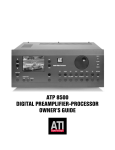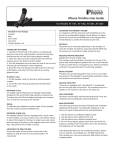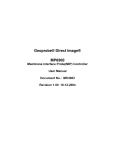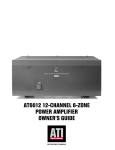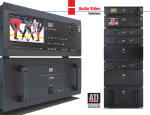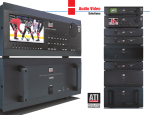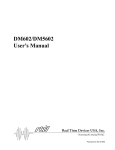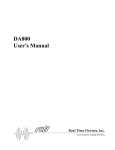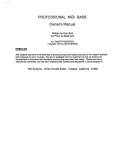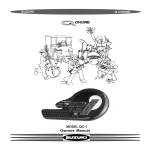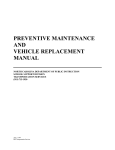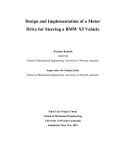Download ATI AT602 2-Channel Amplifier
Transcript
AT602 AND AT1202 2-CHANNEL POWER AMPLIFIER OWNER’S GUIDE TRANSLATING TECHNOLOGY Please Read First Safety Instructions WARNING: TO REDUCE THE RISK OF FIRE OR ELECTRIC SHOCK, DO NOT EXPOSE THIS UNIT TO RAIN OR MOISTURE. Read all the safety and operating instructions before connecting or using this unit. CAUTION: To reduce the risk of electrical shock, do not remove the cover (or back). No user serviceable parts inside. Refer servicing to qualified service personnel. WARNING: To reduce the risk of fire or electric shock, do not expose this appliance to rain or moisture. The lightning flash with arrowhead, within an equilateral triangle, is intended to alert the user to the presence of uninsulated “dangerous voltage” within the product’s enclosure that may be of sufficient magnitude to constitute a risk of electrical shock to persons. The exclamation point within an equilateral triangle is intended to alert the user to the presence of important operation maintenance (servicing) instructions in the literature 7accompanying the appliance. PRECAUTIONS: The amplifier is a wideband design with substantial power output capability. Certain precautions must be taken to ensure proper operation. 1. Never expose the unit to moisture 2. Never plug an input cable into the amplifier while the amplifier is turned on. 3. Never apply the “thumb test” (touching the “hot” lead of the input cable with your finger) to the tip of the input cable or input jack of the amplifier. RF rectification and/or hum will be created and could cause damage to the loudspeakers. ATI will not be responsible for damage to the loudspeakers due to improper use of the equipment. 4. Under no circumstances should the output terminals of the amplifier be short-circuited. 5. Avoid restricting the airflow around the unit. Good airflow is necessary to help insure proper operation. 6. Be sure that the loudspeakers connected can handle the output power of the amplifier at the loudspeakers rated impedance. The warranty on the amplifier does not cover damage to loudspeakers that have inadequate power handling capabilities. 7. Do not stack other system components or any other materials directly on top of the unit. The heat dissipating system of the amplifier depends on free flowing air around the chassis. Page 2 All warnings on the unit and in this operating manual should be adhered to. All operating and use instructions should be followed. Do not use this unit near water: for example, near a bathtub, washbowl, kitchen sink, laundry tub, in a wet basement, or near a swimming pool. This unit should be installed so that its location or position does not interfere with its proper ventilation. For example, it should not be situated on a bed, sofa, rug, or similar surface that may block the ventilation openings: or placed in a built-in installation, such as bookcase or cabinet, that may impede the flow of air through its ventilation openings. The unit should be situated away from heat sources such as radiators, heat registers, stoves, or other devices (including amplifiers) that produce heat. The unit should be connected to a power-supply outlet only of the voltage and frequency marked on its rear panel. The power-supply cord should be routed so that it is not likely to be walked on or pinched, especially near the plug, convenience receptacles, or where the cord exits from the unit. Clean unit only as recommended in this instruction manual. The power-supply cord of the unit should be unplugged from the wall outlet when it is to be unused for a long period of time. Care should be taken so that objects do not fall, and liquids are not spilled, into the enclosure through any openings. The unit should be serviced by qualified service personnel when: A. The power cord or the plug has been damaged; or B. Objects have fallen, or liquid has been spilled, into the unit; or C. The unit has been exposed to rain, or liquids of any kind; or D. The unit does not appear to operate normally, or exhibits a marked change in performance; or E. The device has been dropped, or the enclosure damaged. To prevent electric shock, do not use the polarized plug with an extension cord, receptacle or other outlet unless the blades can be fully inserted to prevent blade exposure. Table of Contents Features Please Read First ............................................................ Page 2 Safety Instructions ........................................................ Page 2 Table of Contents .......................................................... Page 3 Introduction ................................................................... Page 3 Features ........................................................................... Page 3 Unpacking ....................................................................... Page 3 Placement ....................................................................... Page 3 Rack Mounting ............................................................... Page 3 Getting to Know the Rear Panel .................................. Page 4 Connecting Your Amplifier........................................... Page 5 Input Connections ......................................................... Page 5 Speaker Connections..................................................... Page 5 Making Rear Panel Connections ......................... Pages 6 & 7 Power Control Connections ......................................... Page 8 Power Connection ......................................................... Page 8 Amplifier Operation ...................................................... Page 8 Manual On ...................................................................... Page 8 Automatic On ................................................................. Page 8 Gain Controls ................................................................. Page 8 AC Line Connector and Power Cord ........................... Page 8 AC Fuse ............................................................................ Page 9 Clip Limiters ................................................................... Page 9 Protection Circuitry....................................................... Page 9 ATI Service Information ............................................... Page 9 Care, Maintenance and Cleaning................................. Page 9 Trouble Shooting ........................................................... Page 9 A Few Words About Hum and Noise.......................... Page 10 Potential Ground Loops in a Complex A/V System...Page 10 Power Amplifier Specifications ................................. Page 11 Warranty Terms and Conditions ............................... Page 12 Your new ATI amplifier is a state of the art, high performance, audio component. It is built utilizing totally complementary circuitry. A custom-designed, toroidal transformer drives the high current power supply with multiple windings for each channel. Each channel employs an advanced optically coupled protection circuit that replaces the need for bothersome fuse changes. The amplifier is cooled by convection through the use of custom designed, efficient heat sinks. AT602 & AT1202 Power Amplifiers Congratulations! Thank you for purchasing an ATI Power Amplifier. Designed, engineered and manufactured in the United States, it has been carefully designed to deliver the best possible audiophile-grade performance as well as the most reliable operation. In order to receive the maximum performance from your new amplifier, please take a few minutes to read this manual. This important information will help you make certain that the amplifier is properly configured for operation with the rest of the equipment in your system. If you have any questions about this product, its installation or operation, please contact us via e-mail at [email protected] or via telephone at 888-777-8507. Unpacking The carton and packing materials used in shipping your new amplifier were specially designed to protect it from the shock and vibration of shipping. We strongly suggest that you save the carton and packing materials to use if you move, or if the unit ever needs to be shipped back to us for any reason. Should you discover that your amplifier has been damaged during shipping, please contact your dealer or ATI immediately and request the name of the carrier so a written claim may be made. THE RIGHT TO A CLAIM AGAINST A PUBLIC CARRIER CAN BE FORFEITED IF THE CARRIER IS NOT NOTIFIED PROMPTLY IN WRITING AND IF THE SHIPPING CARTON AND PACKING MATERIALS ARE NOT AVAILABLE FOR INSPECTION BY THE CARRIER. SAVE ALL PACKING MATERIALS UNTIL THE CLAIM IS SETTLED. Placement During normal home operation the heat sinks on the amplifier will become warm. However, there are instances during high level playback into low impedance speakers when the heat sinks will become much warmer than usual. To ensure the amplifier’s trouble-free operation, it is necessary to provide adequate ventilation for the heat sinks. Your amplifier should be kept away from external sources of heat such as radiators and hot-air ducts. The amplifier should never be placed with other heat-producing components in a cabinet or enclosure lacking free airflow. Do not stack other components on top of your amplifier. Rack Mounting Your amplifier may be mounted in a standard 19-inch rack by using the optional 19-inch rack mount adapter. A rack mount kit is available for your amplifier that allows it to be mounted face forward or back forward. Be careful to follow the instructions that come with the rack mount kit to ensure correct and safe mounting. Page 3 Getting to Know the Rear Panel A Audio Inputs Use the INPUT jacks to connect to the outputs of a preamplifier, receiver with preout connections, CD player, or other control devices. F AC Fuse Your amplifier is supplied with a rear panel mounted main AC fuse. This main fuse may need replacement if the unit will not turn on. Never replace the the main fuse with other than the one indicated. B Input Gain Controls Use these to adjust the input gain of each channel. WARNING: Always turn off the amplifier and unplug the power cord before making any electrical connections. C Product Serial Number Write this number in the space provided on page 10 for future reference. G AC Input Use the included power cord to connect your amplifier to an AC power source. D Remote Trigger Input Use the REMOTE TRIGGER jack to connect to a compatible preamplifier, source device, or other product with a 3.3-24VDC output. H Speaker Outputs Use the OUTPUT binding posts to connect the amplifier to your speakers; red for positive, black for negative. NOTE: The picture below is an AT1202. The AT602 is virtually identical in appearance. E Master Power Switch Turns the current to the amplifier on or off. A C Page 4 D B E F G H Connecting Your Amplifier When making connections between any source components and the amplifier, or when making connections to any speaker, be certain that both the input devices and the amplifier are turned off. To assure that there will be no unwanted signal transients that can damage equipment or speakers, it is always best to unplug all equipment before making any connections. Input Connections Connecting the amplifier to your source equipment is simple. Using high-quality audio interconnect cables, match the output channel designations on the rear of your source equipment to the input jacks on the rear panel of your amplifier that have the same channel name. When making connections with RCA type plugs on interconnect cables, make certain to gently, but firmly, insert the plug into the jack. Loose connections can cause intermittent sound and may damage your speakers. Some quality RCA plugs may be very tight, and it is important to assure a proper connection between the interconnection cable and the input jack. Speaker Connections To assure that the high quality signals produced by your amplifier are carried to your speakers without loss of clarity or resolution, we recommend that you use high quality speaker wire. Many brands of wire are available; the choice may be influenced by the distance between your speakers and the amplifier, the type of speakers you use, personal preferences, or other factors. Regardless of the brand or type of speaker wire selected, we recommend that you use a wire constructed of fine, multi-strand copper with a gauge of 14 or less. In specifying wire, the lower the number, the thicker the cable. Wire with a gauge of 16 may be used for short runs of less than twenty feet. We do not recommend that you use any wires with an AWG equivalent of 18 or higher due to the power loss and degradation in performance that will occur. To connect the amplifier to your speakers, a pair of binding posts is provided for each channel output. These posts will accept bare wire, spade lugs or banana type plugs. If bare wire is used for the connections, strip approximately 1/2 inch to 3/4 inch of insulation from the end of each wire and carefully twist the strands of each conductor together. Be careful not to cut the individual strands or twist them off. All strands must be used for optimal performance. Correct polarity connections are important to maintain proper speaker phasing. When speaker phasing is correct, all speakers move in and out at the same time, preserving the imaging of the program material. Out-of-phase connections mean that some speaker cones will be moving in, while others move out. This will cause indistinct or confused imaging, and muddled and cloudy sounds. To avoid incorrect phasing or polarity, be certain to use wire that has distinct markings, colors, stripes, wording, or grooves on each side of the speaker cable. When making connections to the amp and speakers, adhere to a consistent pattern of using one side of the wire to the red terminals and the other side to the black terminals. When using cable with markings on one side only, traditional convention is to consider the marked side of the wire as the red, or positive (+) connection, and the non-marked side as the black or negative (–) connection. Next, loosen the knobs of the amplifier’s speaker output terminals, far enough so that the pass through hole is revealed. Follow the proper connection instructions for your system with regard to which terminals are used. Once the connections are made, twist the cap back so that the connection is secured, but do not over tighten or use tools, as this may break the delicate wire strands and decrease system performance. If you are using spade lugs, connect them to the speaker wire using the manufacturer’s instructions, and then loosen the caps on the speaker terminals. Place lugs between the plastic cap and the back of the terminal. Be sure to observe proper polarity, using the appropriate speaker hook-up icons for your system’s configuration. Using your fingers, tighten to obtain a positive contact. When using banana plugs, connections may be made by simply inserting the jack affixed to your speaker wire into the hole provided on the rear of the colored screw caps on the binding posts. Before using banana type jacks, make certain that the plastic screw caps are firmly tightened down by turning them in a clockwise direction until they are snug against the chassis. This will insure that the maximum surface area of the plug is in contact with the jack. Be certain to observe proper polarity. Run the cables to the speaker locations. Do not coil any excess cable, as this may become an inductor that creates frequency response variations in your system. Finally, connect the wires to the speakers, again being certain to observe proper polarity. Remember to connect your negative, or black wire, to the matching terminal on the speaker. The positive, or red wire, should be connected to the matching terminal on the speaker. NOTE: While most speaker manufacturers adhere to an industry convention of using red terminals for positive connections and black terminals for negative, some manufacturers may vary from this configuration. To assure proper phase connections, and optimal performance, consult the identification plate on your speaker terminals, or the speaker’s manual to verify polarity. If you do not know the polarity of your speaker, consult the speaker’s manufacturer for further information. Page 5 Making Rear Panel Connections When connecting the amplifier to your source equipment, match the output channel designations on the rear of your source equipment to the input jacks on the rear panel of your amplifier that have the same channel name. Correct polarity connections are important to maintain proper speaker phasing. When making connections to the amp and speakers, adhere to a consistent pattern of using one side of the wire to the red terminals and the other side to the black terminals. NOTE: The picture here is an AT1202. The AT602 is virtually identical in appearance. NOTE: This diagram shows the back of the amplifier, preamplifier and all speakers. Therefore, the right speakers are on the left side of the diagram, and the left speakers are on the right side of the diagram. ATI ATP7500 Preamplifier/Proce In This Example Being Used Fo Right Speaker Page 6 essor Shown as a Typical Example e, The Amplier Is or a 2nd Zone Left Speaker Page 7 Power Control Connections Amplifier Operation Your amplifier features a built-in remote turn-on system that will automatically switch the amplifier on when another device in the system is switched on. After all connections have been made you are ready for operation. First, turn on the source component in your system. It is always a good idea to turn on your amplifier LAST. This avoids the possibility of any turn on pops or transients from other equipment being amplified and sent to your speakers where they may cause damage. Always start with a low volume level on your controller or preamp to avoid damage to your speakers. Remote Turn-On Using Products Equipped With a Low Voltage Trigger Jack Press the front panel power switch on the amplifier so that it is in the ON position. Then, using an accessory cable with a 3.5mm mono mini-plug on each end, connect the trigger-output jack on the rear of the source device to the trigger input jack on the back panel of the amplifier. When these connections are made, the amplifier will automatically turn on whenever the triggering device is turned on. Remote Turn-On Using External AC to DC Power Converter If your source device does not have a dedicated trigger jack, it is still possible to activate the unit for automatic turn on when a Switched Outlet is available on the rear of the source device. To control the amplifier in this fashion, you will need a small AC to DC power converter, capable of delivering a 3.3 to 24 volt DC signal. The DC voltage should terminate in a standard 3.5mm type mini plug. This type of converter may be obtained as a Power Adapter from many electronics retailers. When installing, press the Main Power Switch on the front panel of the amplifier in so that it is in the ON position. Plug the AC adapter into a switched outlet on the source device that will be activated when you wish to have the amplifier turn on. This may be the switched outlet at the rear of an AC receiver or other audio equipment. Connect the 3.5mm miniplug from the adapter to the trigger-input jack on the back panel of the amplifier. The amplifier will now turn on and off automatically, based on the status of the controlling device. Power Connection Once all audio and system connections have been made, connect the supplied power cord to the amplifier first, and then connect it to an AC power source. Please make certain that the amplifier is turned off and that the device connected to the remote trigger input is off when connecting the power cord and plugging it into an AC outlet. CAUTION: Do not plug the amplifier directly into the “Switched Accessory” outlet of another device! These outlets are intended for use with low current draw products having a low current draw, such as tuners, CD players or cassette decks. These cannot handle the high current draw of a power amplifier. Using these outlets for a power amplifier is a significant safety hazard. NOTE: It is not recommended that you connect other power amplifiers, or products with a high current draw, to the same AC power circuit as the amplifier. If this is unavoidable, the Ultra-Soft-Start circuitry of your amp will prevent excessively high inrush current. Manual On Simply press the front panel Power switch to the “up” position. There will be a short pause from the time the power is turned on until power is applied to the speakers. This is intentional, and protects your speakers from damage while the amplifier stabilizes. To turn the unit off, press the Power button downward. The ON indicator light will go out and the STANDBY light will illuminate. Automatic On Make certain that the connection to the controlling device is correct. Whenever the controlling device is turned on, the amplifier will automatically turn on after a short pause. This pause is intentional, and it protects your speakers from damage while the amplifier stabilizes. You may also hear a relay click as during start up. This is also normal. To turn off your amplifier, simply turn off the device feeding the amplifier it’s audio signals. The amplifier will automatically go into a standby mode in a few moments. Gain Controls Level adjustments may be made at the rear of the amplifier. The circuitry in your new amplifier may be different from your previous one, and by checking the output levels you will make certain that the control device, amplifier and speakers are properly matched. Be careful in adjusting these controls as they operate in conjunction with the volume control(s) on your source device. Be sure that the volume control(s) on the source device is turned down before adjusting the controls on the amplifier. AC Line Connector and Power Cord Your amplifier is supplied with an internationally approved (IEC) power line connector that accepts the supplied detachable, high-current capacity power cord. WARNING: Under no circumstances should the round third prong on the plug be cut, bent or in any other way defeated as this may result in severe shock. WARNING: Always turn off the amplifier and unplug the power cord before making any electrical connections. Page 8 AC Fuse ATI Service Information Your amplifier is supplied with a rear panel mounted main AC fuse. This main fuse may need replacement if the unit will not turn on. Never replace the the main fuse with other than the one indicated. The AT602 and the AT1202 do not contain any user serviceable parts inside. If you suspect a problem that may require service assistance, contact us at [email protected], or by phone at 888-777-8507. It is important that only an authorized service agent carry out any repairs. This will assure proper service and preserve the protection of your Limited Warranty. Keep your sales slip or receipt in a safe place with this manual so that it will be available to verify the purchase date, should you experience a problem covered by our warranty. Clip Limiters Your amplifier is equipped with a unique clip limiting circuit. If the amplifier is driven beyond the point of maximum output the clip limiting circuit will engage and prevent potentially damaging distortion from reaching your loudspeakers. The amplifier will continue to operate with no apparent change in performance. This feature is automatic and requires no adjustment or maintenance. Protection Circuitry Your ATI amplifier uses an advanced optically coupled protection circuit that does not require fuses and is completely isolated from the audio path. In the event that the amplifier senses a shorted speaker wire the protection circuit will engage shutting down the output and will sample the state of the amplifier every 7 seconds (nominal). The output will be cut off as long as the short exists. The amplifier will begin to operate normally after the shorted situation is repaired. If this should happen, first check all speaker wire connections, both at the speakers themselves and at the speaker terminals on the back of the amplifier to make certain that none of the strands from any channel touch another channel, and that none of the strands from a "positive" terminal touch those from a "negative" terminal. Even a few stray wire strands can cause the unit to go into the protection mode. After checking all speaker connections, turn the unit back on. If it continues to turn off, check your speakers to verify that they are operating properly. If all other potential sources of trouble check out properly, contact ATI for further assistance and information. Care, Maintenance and Cleaning When the unit becomes dirty, wipe it with a clean, soft, dry cloth. If necessary, first wipe the surface with a slightly dampened soft cloth with mild soapy water, then with a fresh cloth dampened with clean water. Wipe dry immediately with a dry cloth. NEVER use benzene, thinner, alcohol or any other volatile cleaning agent. Do not use abrasive cleaners, as they will damage the finish of the metal parts. Avoid spraying insecticide, waxes, polishing agents, or any aerosol product near the unit. Troubleshooting Your ATI amplifier is designed for trouble free operation. If you follow the instructions in this manual you should enjoy many years of high quality listening enjoyment. However, as with any sophisticated electronic device, there may be occasional problems upon initial installation, or during the life of the unit. The items on the list below are a brief guide to the minor problems that you may be able to correct yourself. If these solutions do not rectify a problem, or if the problem persists, contact us for assistance. Problem Solutions Amplifier will not turn on Master Power Switch tuned off (No power light LED). Turn on Master Power Switch. Amplifier will not turn off. Remote trigger cable not properly connected. Verify connection of trigger cable at both ends. Amplifier turns on, but no audio from one or more channels. Input plugs not connected to proper jack or are loose. Check input connections. No audio from one or more channels. Speakers not connected properly. Check speaker connections at amp and speaker. Audio levels differ. Improper settings or output levels from source device. Check the settings on your preamp, processor or controller. Also check settings of the rear panel gain conrols on your amp. Audio plays, then cuts off. Amplifier shorted. Check speaker connections for short circuit at amp and speaker. Page 9 A Few Words About Hum and Noise Audible hum, or a discernable low frequency noise, is one of the most common problems in audio/video systems. This hum, which may be present even when the volume is at a low level, is usually caused by a problem known as “ground loops”. A ground loop occurs when there is a difference in ground voltages between two or more components that are connected electrically. This, in turn, creates multiple current paths and causes the low-level noise, or hum. The growing sophistication and complexity of home audio/video systems, and the increased number of components used to create these systems has dramatically increased the potential for the possibility of ground loops. While it is natural to suspect that the components in your system are the cause of the hum, in many cases the cause may be due to other conditions. In particular, cable TV connections from outside the house have become a major source of hum. In most cases, one of the following suggestions should help you to solve a hum problem in your system. Please try these steps in the sequence shown, proceeding from one step to the next if the prior suggestion does not eliminate the problem. Potential Ground Loops in a Complex A/V System Suggestion #1: To determine if a cable TV connection is responsible for the hum, first turn all components off. Disconnect the cable TV feed to your system at the first place where it connects to your components. Alternatively, disconnect the cable TV wire where it is connected at the wall outlet. Turn your system back on, and listen if the hum has disappeared. If removing the cable TV feed has eliminated the hum, you will need to insert a Ground Loop Isolator before reconnecting the cable TV feed, or contact your cable TV operator to see if they can better isolate your cable feed. Suggestion #3: Ground loop problems may also be caused by poor grounding of the electrical system in your home, particularly when there are multiple components with three prong, grounded, power cords. Try unplugging these components one at a time, and see if one or all of them is causing the problem. The ultimate solution to this type of problem is to re-wire your house with an isolated, star type-grounding configuration. We recognize, however, that this may be impractical and expensive. In some cases, the use of an approved AC Power Isolation Transformer of sufficient capacity may solve this problem. WARNING: If you suspect that the grounding system in your home’s electrical wiring is causing the hum problem, it is important that you do not make any changes to the wiring yourself. Only a licensed electrician should make any changes to household wiring, and they must be made in full compliance with all local building, safety and electrical codes. Suggestion #4: Hum may also be caused by faulty earth grounds in your home’s electrical system. In the past, cold water pipes were often used for the earth ground, so it is important to make sure that your ground connection is still valid and has not become loose or corroded. The cold water pipe method may no longer be valid in some locations due to requirements that the water meter be isolated from the water mains with a length of PVC pipe, thus interrupting the ground circuit. The safest, and most reliable, approach may be to provide your own ground. This can be accomplished by having a licensed electrician drive at least five feet of copper-jacketed steel grounding rod into the earth, and using that for your grounding connection. If the hum persists after all of the above suggestions have been tried, contact the ATI customer service department for assistance. For Future Reference Model Number______________________________ Serial Number ______________________________ Date of Purchase ____________________________ Suggestion #2: Turn off all components in your system, and then disconnect the input cables at the amplifier. Turn the amplifier back on, and see if the hum is still present. If the hum disappears, the fault may be in the input cables used. Try replacing them with cables that have better shielding, and make certain that the input cables are not running on top of any AC power cords. Change the cables one at a time to determine if one, or all cables is responsive. If the hum disappears when the input cables are disconnected, but returns after the cables are changed and the system re-connected, the problem may be caused by your source device. Where Purchased ___________________________ Notes _____________________________________ ___________________________________________ ___________________________________________ ___________________________________________ ___________________________________________ ___________________________________________ Page 10 ___________________________________________ Power Amplifier Specifications The following applies to all channels being driven simultaneously with 8 ohm loads and an input sensitivity of 28dB gain unless otherwise specified. Series AT602 AT1202 2 2 EIA 1kHz Output Power at 8 Ohms* 75 watts 140 watts EIA 1kHz Output Power at 4 Ohms* 110 watts 220 watts FTC Full Bandwidth Output Power at 8 Ohms** 60 watts 120 watts FTC Full Bandwidth Output Power at 4 Ohms** 90 watts 180 watts Input Sensitivity for Full Rated Power 0.9 Volts 1.3 Volts Number of Channels Frequency Response at Rated Output 20Hz to 20kHz ±0.1dB Phase Response +5 to -15 degrees from 20Hz to 20kHz at 1 watt Signal-to-Noise Ratio “A-Weighted” Greater than 120dB below rated FTC Full Bandwidth Power Total Harmonic Distortion (THD) Less than 0.03% at full rated FTC power Less than 0.005% at full EIA power at 1kHz Intermodulation Distortion (IMD) Less than 0.03% at full rated FTC power Less than 0.005% at full EIA power at 1kHz Load Impedance Power Bandwidth FTC Damping Factor Crosstalk Gain Safe with all types of loads. Rated for 4 to 16 ohms +0-3db from 5Hz to 100kHz Greater than 400 from 10Hz to 400Hz Greater than –100dB from 20Hz to 20kHz Voltage gain of 24dB Slew Rate Input Impedance Remote Trigger Voltage 50V/microsecond Nominally 28k ohms 3.3 to 24 Volts DC at 5 millamperes or greater DC Output Offset Power Requirements Chassis Dimensions (W x H x D) Inches Less than ±5mV 120 VAC (other voltages available on export models) 17 x 3.5 x 10.25 17 x 3.5 x 12 431.8 x 88.9 x 260.35 431.8 x 88.9 x 304.8 Net Weight (lbs/kg) Model Dependent 32/14.55 36/16.36 Shipping Weight (lbs/kg) Model Dependent 44/20.42 48/22.29 Chassis Dimensions (W x H x D) Millimeters *EIA 1kHz Power refers to maximum average power in watts at 1kHz with 0.005% THD and noise. **FTC Full Bandwidth Power refers to maximum average power in watts from 20Hz to 20kHz with 0.03% THD and noise. The contents of this manual are Copyright © 2003 by Amplifier Technologies, Inc. and may not be duplicated or reproduced by any means, whether physical, electronic or otherwise without prior written consent from Amplifier Technologies, Inc. Specifications are those in effect at the time of printing. Amplifier Technologies, Inc. reserves the right to change specifications or designs at any time without notice. Page 11 90-Day Limited Warranty Terms and Conditions (7-Year Optional Extended Warranty) This ATI product is warranted against defects in materials and workmanship for 90 days from the date of purchase by the original owner. The date of purchase shall be established by the original owner presenting to the ATI Customer Service Facility the original owner’s purchase receipt or sales slip showing from whom the product was purchased, the date of purchase and the purchase price of the unit. In the event that proof of purchase cannot be established as stated in the preceding sentence, the warranty period shall commence on the date of manufacture, provided the serial number on the unit has not been altered in any manner. During the warranty period, ATI will repair, or at its option, replace at no charge, components that prove to be defective provided the product is returned in accordance with the shipping instructions that are contained in the unit. The unit is to be sent PREPAID in the original carton and packing along with a detailed description of the problem to ATI in the event it needs factory servicing. ATI will return it prepaid to you upon completion of the service. Optional Extended Warranty Program The standard 90 Day Limited Warranty will be extended to a 7 Year Limited Warranty if the following conditions are met: The ATI product is purchased from an authorized ATI reseller. The customer completes the registration card. The customer returns the completed registration card AND copy of original bill of sale to ATI within 14 days of purchase. ATI will send confirmation of extended warranty when all conditions are met. This extended warranty is transferable to subsequent purchasers as long as all Optional Extended Warranty conditions are met. Amplifier Technologies, Inc. 19528 Ventura Boulevard #318 Tarzana, CA 91356 (818) 343-4777 Fax: (818) 343-7444 http://www.ati-amp.com EMAIL: [email protected] Transferability The above warranties are transferable to subsequent owners as long as all the conditions are met under the Optional Extended Warranty Program. The warranty is not transferable if the unit(s) was originally purchased from an unauthorized seller. The above warranties do not apply if the product has been damaged by accident or misuse or as a result of modification by other than the ATI factory service facility. ATI shall not be held liable for incidental or consequential damages of any kind arising from the sale or use of its products. Some states do not allow the exclusion or limitation of incidental or consequential damages, so the above limitation or exclusion may not apply to you. THERE ARE NO WARRANTIES GIVEN BY ATI THAT EXTEND BEYOND THE DESCRIPTION ON THE FACE HEREOF. ALL IMPLIED WARRANTIES OF FITNESS FOR PURPOSE SOLD, MERCHANTABILITY, DESCRIPTION, QUALITY PRODUCTIVENESS OR ANY OTHER MATTERS ARE LIMITED TO THE TERM OF THE EXPRESS WARRANTIES HEREIN STATED. Some states do not allow limitations on how long an implied warranty may last, so the above limitation may not apply to you. Obligation to Make Changes Products are sold on the basis of specifications applicable at the time of sale. ATI shall have no obligation to modify or to update products once sold. This warranty gives you specific rights and you may also have other rights that vary from state to state. This warranty is applicable only in the United States. Warranty Outside the United States ATI has formal distribution agreements in many countries. The ATI importer in those countries has assumed the responsibility for servicing ATI products. Please contact the dealer or distributor in the country where you purchased your product for any service issues.













